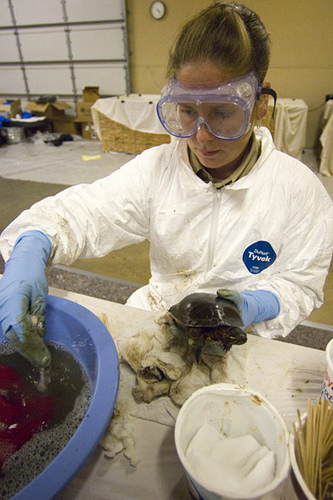
A turtle rescued from the Kalamazoo River is cleaned. Click to embiggen. (Photo courtesy of the U.S. Fish and Wildlife Service.)
Just under two years ago, on July 25 at 6 p.m., a pipeline carrying tar-sands oil split open in southern Michigan. Over the course of the next 17 hours, diluted bitumen — a particularly dense form of petroleum — spilled into the Kalamazoo River and a tributary. Estimates of the amount that spilled started at 819,000 gallons and went up, eventually topping 1,000,000. The spill made nearby residents sick: headaches, nausea, breathing difficulties. Many birds fared far worse.
It was the worst onshore spill in American history. And the entire thing was completely preventable.
Today, the National Transportation Safety Board released the results of its investigation into the spill. The San Francisco Chronicle summarizes:
Enbridge Inc. knew in 2005 that its pipeline near Marshall, a city 95 miles west of Detroit, was cracked and corroded, but it didn’t perform excavations that ultimately might have prevented the rupture, NTSB investigators told the five-member board at a meeting in Washington.
Investigators also faulted Enbridge control center personnel for twice pumping more oil into the line after the spill began and failing to discover what had happened for more than 17 hours, when an employee of a natural gas company notified them.
In short: Enbridge didn’t recognize that the pipeline was likely to rupture and, once it did, made a bad situation worse. From the report:
The rupture and prolonged release were made possible by pervasive organizational failures at Enbridge Incorporated (Enbridge) that included the following:
- Deficient integrity management procedures, which allowed well-documented crack defects in corroded areas to propagate until the pipeline failed.
- Inadequate training of control center personnel, which allowed the rupture to remain undetected for 17 hours and through two startups of the pipeline.
- Insufficient public awareness and education, which allowed the release to continue for nearly 14 hours after the first notification of an odor to local emergency response agencies.
Happily, the spill and Enbridge’s even-then-known failures didn’t keep the company’s CEO from being named “Outstanding CEO of the Year” in 2011.
That the pipe contained tar-sands oil may have contributed to the problem. Anthony Swift of the Natural Resources Defense Council summarizes how:
- The pipeline’s failure was in part due external corrosion which combined with stress corrosion cracking, led to a pipeline failure. We’ve discussed for some time how the higher temperatures of tar sands can speed corrosion while pressure variations that can occur in viscous, or thick, tar sands can contribute to cycle pipeline stress.
- Enbridge’s failure to identify the spill was in a large part due to a leak detection system prone to false alarms. We have discussed in some detail that more viscous, or thicker, tar sands leads to far more “noise” for pipeline leak detection systems which may trigger false alarms — meaning that a real spill is not identified.
- Enbridge was not prepared for a spill involving oil which did not float on the top of a river body. As we’ve seen, a large percentage of tar sands diluted bitumen sinks in waterbodies soon after a spill. The company not only did not have sufficient spill response equipment, but they had the wrong type of spill response equipment which only contained oil floating on the water’s surface.
It is impossible to consider what happened with the Enbridge spill outside of the context of the current debate over the Keystone pipeline. Concern over a tar-sands spill prompted the governor of Nebraska to oppose the Keystone pipeline’s proposed route; similar arguments are a cornerstone of pipeline opposition.
The most important point comes from an opinion piece in the Saskatoon Star-Phoenix. “All technologies fail sooner or later. If the Northern Gateway pipeline and supertanker port or the Keystone pipeline are built, there will be spills, including disastrous spills.” The damage from the Enbridge spill was compounded by errors on the part of the company. But the primary contributing factor to the spill — a factor entirely the fault of Enbridge and human decision-making — was creating the pipeline in the first place.




